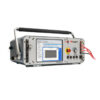EZ-THUMP™ 3 kV & 4 kV, Models V2
Portable Cable Fault Location Systems for Low Voltage Cables
The new dual-stage 3 kV EZ-Thump is the first of its kind in the entire market, and along with the updated 4 kV singlestage unit they are portable, compact and lightweight, battery
and AC line operated cable fault location systems specifically designed for fault locating of shielded and unshielded low voltage power cables.
Due to their portable, robust and (wet) outdoor-capable enclosure, they are ideally suited for all typical fault locating operations on LV cables either in industrial applications up to
3 kV or 4 kV, street light fault locating or fault locating of LV power circuits in the utility industry.
The EZT3DV2 model is the only dual-stage 3 kV unit in the market which addresses LV cables with either 600 V or 1000 V ratings and a max permissible test level of 3 Uo (1.8 kV or 3 kV).
The EZ-Thump units offer:
- TDR method to prelocate very low resistance cable faults.
- Arc Reflection Method (ARM®) prelocation of high resistance/flashover faults.
- Dual-stage 500 Joule surge generator for pinpointing of high resistive faults at 0-1.5 kV or 0-3 kV (3 kV model) or as
single-stage 500 J 0-4 kV (4 kV model). - Testing 0-1.5 / 0-3 kV or 0-4 kV for breakdown detection.
- Insulation resistance measurement.
- Sheath testing and sheath fault locating.
- Dual stage 0-1.5 kV / 0-3 kV or single-stage 0-4 kV DC testing.
APPLICATIONS
Testing (proof/insulation testing, sheath testing)
Used to test the dielectric strength of the cable or sheath insulation and, if the test fails, to determine the breakdown voltage. For this purpose a test voltage up to 1.5 kV, 3 kV kV or 4 kV is applied to the cable under test indicating the resistance value.
Fault prelocation
After identifying the type of fault as high resistance/flashover, prelocation of any concentric neutral type LV cable can be determined using ARM. In ARM, the electrical arc from the flashover creates a temporary “jumper” to the neutral. During this condition, a standard TDR measurement is made into what is basically a short circuit fault providing a negative
reflection at the location of the fault. Multi-conductor nonshielded LV cables with the same type of fault can be typically processed in the same way (phase to phase or phase
to neutral).


 megger-ez-thump3
megger-ez-thump3









